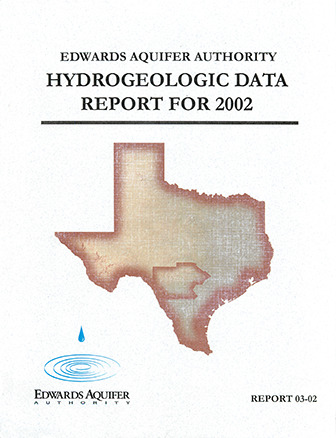Edwards Aquifer Authority Hydrogeologic Report for 2002

| Author | Hamilton JM, Johnson S, Esquilin R, Thompson EL, Luevano G, Wiatrek A, Mireles J, Gloyd R, Sterzenback J, Hoyt JR and Schindel G |
| Year | 2003 |
| Description | Annual report for 2002 on recharge, discharge, water levels and water quality in the Edwards Aquifer San Antonio Region |
| Report Number | 03-02 |
| Publisher | Edwards Aquifer Authority |
| Location | Edwards Aquifer - San Antonio Area |
| Cover | View Download |
| File | View Download |
| Summary |
|
(Excerpted from the report Summary) Throughout most of the year water levels exceeded average levels in the Authority’s index wells in Uvalde, Hondo, and San Antonio. Below average precipitation in the late spring and early summer resulted in water levels falling to the level where water use restrictions would be required. Above average precipitation in late June and July was sufficient to recharge the aquifer and reduce demand, which moderated the typical seasonal decline of water levels for that time of year. Consequently, the Authority did not institute water use restrictions during the summer of 2002. …Weather conditions during 2002 limited the number of days cloud seeding operations could be performed under the Authority’s Precipitation Enhancement Program. … Total recharge to the Edwards Aquifer was 1,665,200 acre-feet in 2002, approximately 230 percent above average for the period of record (1934-2002). … Only 1958, 1987, and 1992 experienced higher recharge volumes. …The water level at J-17 reached a high for the year of 697.9 feet msl on November 10, 2002, representing the third highest annual maximum for the period of record for this well. … In 2002 discharge from the Edwards Aquifer through wells and springs totaled 997,100 acre-feet, which exceeded the average for the period of record (1934-2002). … For the period of record, 2002 experienced the second highest annual discharge from springs, exceeded only by the 1992 discharge value. The above average precipitation, recharge, and aquifer water levels in 2002 resulted in the above average springflow. … Water samples from each sampling event were analyzed for major ions, metals, TDS, hardness, and nutrients. Water samples collected from 16 wells, the nine stream locations, and the five spring groups were also analyzed for pesticides and herbicides. Water samples from 27 wells and the five spring groups were also analyzed for volatile organic compounds (VOCs). Water samples from 11 wells and the five spring groups were also analyzed for semivolatile organic compounds (SVOCs). … For the samples collected in 2002, thallium was detected slightly above the MCL of 0.002 mg/L in water samples from seven wells, five of which are located in the saline zone. Two other metals, antimony and silver, were detected in three wells in the freshwater portion of the aquifer at concentrations slightly above their respective MCLs. … Antimony was also detected at concentrations slightly above the MCL in three surface water and five spring water samples. Currently, no trends for these metals are indicated by the sample results; however, continued monitoring at these wells will indicate if any trends are developing. For samples collected in 2002, nitrate concentrations ranged from below the laboratory reporting limit to 7.48 mg/L in samples from wells, streams, and springs in the Edwards Aquifer region. … None of the samples collected exceeded the MCL of 10 mg/L for nitrate. … The herbicides ethoprop, silvex, and dicamba were detected in three well samples at 0.077 μg/L, 0.061 μg/L, and 0.09 μg/L, respectively. The herbicides ethoprop and atrazine were each detected in one stream sample at 0.076 μg/L and 0.10 μg/L, respectively. No herbicides were detected in spring water samples. The pesticide compounds lindane and diazinon were detected in one well sample at 0.01 μg/L and 0.014 μg/L respectively. The pesticide compound diazinon was detected in one stream sample. … Five well samples contained detectable concentrations of tetrachloroethene (PCE). Well YP-69-51-114, located in the City of Uvalde, contained PCE at 4.0 μg/L. The other four wells, located in Bexar County, contained PCE at concentrations ranging from 0.4 to 0.8 μg/L (concentrations less than the laboratory reporting limit). The MCL for PCE is 5.0 μg/L. … Water quality in the aquifer is generally excellent. Edwards Aquifer water is generally of such high quality that it normally requires only chlorination to meet public drinking water standards. However, the detection of VOCs and nitrate in the aquifer is a concern and the Authority will continue to monitor for these compounds to determine possible sources and trends. The Authority’s aquifer-wide water quality sampling program will continue to monitor wells, streams, and springs for indications of water quality impacts. Authority staff and cooperating agencies will continue to analyze any anomalous data and investigate possible sources of contamination. |
Search for Documents
Advance Search
Explore EAA's Scientific Reports
- All Reports
- Overview Studies
- Modeling
- Hydrology and Hydrogeology
- History
- Groundwater Recharge, Recharge Zone
- Groundwater Movement
- Geomorphology and Caves
- Weather Modification
- Geology
- Water Use and Conservation
- Geochemistry
- Water Resources Planning and Management
- Floods and Drought
- Water Quality
- Climatology
- Surface Water / Groundwater Relationship
- Biology
- Springs, Groundwater Discharge
- Archaeology
- RZ Protection
- Aquifer Levels
- Remote Sensing
- Precipitation
